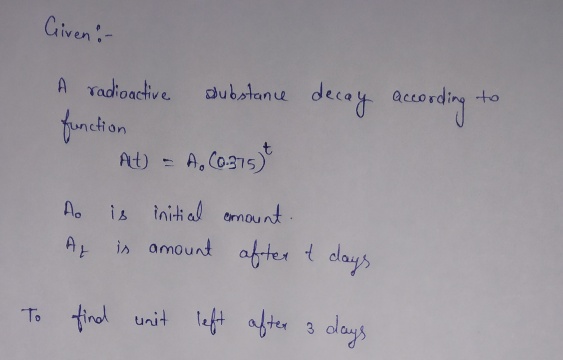**Radioactive Decay Problem** A radioactive substance decays according to the function: \[ A(t) = A_0 (0.375)^t \] where \( A(t) \) is the amount of the substance left after \( t \) days, and \( A_0 \) is the initial amount of the substance. If you start with 7000 units, how many units will be left after 3 days? **Solution:** To find the amount of substance left after 3 days, substitute the given values into the function: \[ A(t) = 7000 \times (0.375)^3 \] Calculate: \[ A(3) = 7000 \times 0.375 \times 0.375 \times 0.375 \] The answer will provide the remaining units after 3 days. **Answer 2: ___________** In this problem, there is a coordinate graph depicted without any specific data points visible. It appears to provide a framework for plotting values potentially related to the function equation mentioned. The graph uses standard Cartesian coordinates with horizontal and vertical axes intersecting at a central point.
**Radioactive Decay Problem** A radioactive substance decays according to the function: \[ A(t) = A_0 (0.375)^t \] where \( A(t) \) is the amount of the substance left after \( t \) days, and \( A_0 \) is the initial amount of the substance. If you start with 7000 units, how many units will be left after 3 days? **Solution:** To find the amount of substance left after 3 days, substitute the given values into the function: \[ A(t) = 7000 \times (0.375)^3 \] Calculate: \[ A(3) = 7000 \times 0.375 \times 0.375 \times 0.375 \] The answer will provide the remaining units after 3 days. **Answer 2: ___________** In this problem, there is a coordinate graph depicted without any specific data points visible. It appears to provide a framework for plotting values potentially related to the function equation mentioned. The graph uses standard Cartesian coordinates with horizontal and vertical axes intersecting at a central point.
Calculus: Early Transcendentals
8th Edition
ISBN:9781285741550
Author:James Stewart
Publisher:James Stewart
Chapter1: Functions And Models
Section: Chapter Questions
Problem 1RCC: (a) What is a function? What are its domain and range? (b) What is the graph of a function? (c) How...
Related questions
Question
![**Radioactive Decay Problem**
A radioactive substance decays according to the function:
\[ A(t) = A_0 (0.375)^t \]
where \( A(t) \) is the amount of the substance left after \( t \) days, and \( A_0 \) is the initial amount of the substance. If you start with 7000 units, how many units will be left after 3 days?
**Solution:**
To find the amount of substance left after 3 days, substitute the given values into the function:
\[ A(t) = 7000 \times (0.375)^3 \]
Calculate:
\[ A(3) = 7000 \times 0.375 \times 0.375 \times 0.375 \]
The answer will provide the remaining units after 3 days.
**Answer 2: ___________**
In this problem, there is a coordinate graph depicted without any specific data points visible. It appears to provide a framework for plotting values potentially related to the function equation mentioned. The graph uses standard Cartesian coordinates with horizontal and vertical axes intersecting at a central point.](/v2/_next/image?url=https%3A%2F%2Fcontent.bartleby.com%2Fqna-images%2Fquestion%2F287f2c38-2a5e-4a59-a1d6-7c77fc20a3cb%2F9a3c9e73-3ba9-485b-8db7-6ecd213d9db2%2Fdpnfdzb.jpeg&w=3840&q=75)
Transcribed Image Text:**Radioactive Decay Problem**
A radioactive substance decays according to the function:
\[ A(t) = A_0 (0.375)^t \]
where \( A(t) \) is the amount of the substance left after \( t \) days, and \( A_0 \) is the initial amount of the substance. If you start with 7000 units, how many units will be left after 3 days?
**Solution:**
To find the amount of substance left after 3 days, substitute the given values into the function:
\[ A(t) = 7000 \times (0.375)^3 \]
Calculate:
\[ A(3) = 7000 \times 0.375 \times 0.375 \times 0.375 \]
The answer will provide the remaining units after 3 days.
**Answer 2: ___________**
In this problem, there is a coordinate graph depicted without any specific data points visible. It appears to provide a framework for plotting values potentially related to the function equation mentioned. The graph uses standard Cartesian coordinates with horizontal and vertical axes intersecting at a central point.
Expert Solution
Step 1

Step by step
Solved in 2 steps with 2 images

Recommended textbooks for you

Calculus: Early Transcendentals
Calculus
ISBN:
9781285741550
Author:
James Stewart
Publisher:
Cengage Learning

Thomas' Calculus (14th Edition)
Calculus
ISBN:
9780134438986
Author:
Joel R. Hass, Christopher E. Heil, Maurice D. Weir
Publisher:
PEARSON

Calculus: Early Transcendentals (3rd Edition)
Calculus
ISBN:
9780134763644
Author:
William L. Briggs, Lyle Cochran, Bernard Gillett, Eric Schulz
Publisher:
PEARSON

Calculus: Early Transcendentals
Calculus
ISBN:
9781285741550
Author:
James Stewart
Publisher:
Cengage Learning

Thomas' Calculus (14th Edition)
Calculus
ISBN:
9780134438986
Author:
Joel R. Hass, Christopher E. Heil, Maurice D. Weir
Publisher:
PEARSON

Calculus: Early Transcendentals (3rd Edition)
Calculus
ISBN:
9780134763644
Author:
William L. Briggs, Lyle Cochran, Bernard Gillett, Eric Schulz
Publisher:
PEARSON

Calculus: Early Transcendentals
Calculus
ISBN:
9781319050740
Author:
Jon Rogawski, Colin Adams, Robert Franzosa
Publisher:
W. H. Freeman


Calculus: Early Transcendental Functions
Calculus
ISBN:
9781337552516
Author:
Ron Larson, Bruce H. Edwards
Publisher:
Cengage Learning